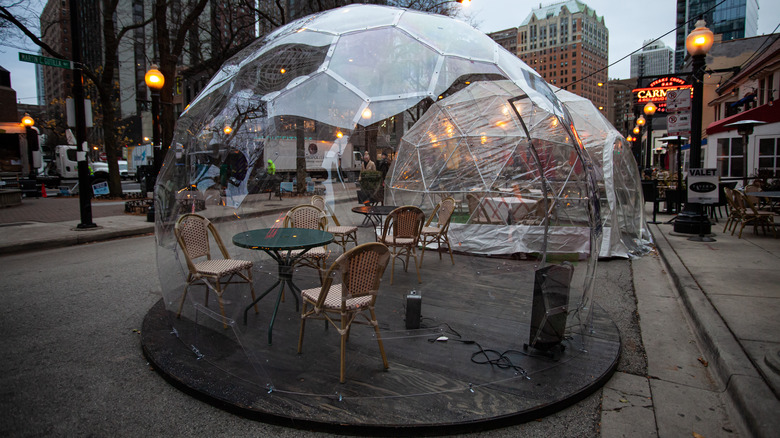How The Omicron Variant Might Change Dining At Restaurants
By now, you've probably heard that there is a new COVID variant. B.1.1.529 aka Omicron, like Delta before it, has been deemed "a variant of concern," according to the World Health Organization. The fact that the coronavirus is mutating is not new. We've seen it happen over and over again during the past two years, but every time a new strain is discovered, the way we act to mitigate the chance of infection does seem to change. In America, in particular, when vaccination rates rose and infection rates started to drop, public health officials eased restrictions, and the CDC conditionally recommended safe ways to gather with friends and family again.
For food lovers, this has meant it's possible to go to your favorite restaurants again. In most states, there are no longer restrictions on indoor dining, with most operating at full capacity. While the regulations do vary slightly across the country, for the most part, people have been able to return to enjoying meals with friends outside of their homes, if they're comfortable doing so. And as winter approaches, it's not surprising that most people are hoping to be able to continue eating inside.
But will that even be possible with Omicron? Will be see a new wave of pandemic-related restaurants closures? Should we avoid them anyway? Should we expect to bundle up in parkas and huddle under heat lamps for the next three months if we want to have something that resembles a restaurant experience?
It's too soon to say how Omicron will affect dining out
The best way to sum up how Omicron may affect dining in restaurants is: "We just don't know yet."
According to the World Health Organization, this is what we know so far: the transmissibility of Omicron, the severity of infection for those with the strain, and the effectiveness of current vaccines against Omicron are still all being studied. Early evidence does suggest that "current vaccines remain effective against severe disease and death" and that the current standard COVID-19 test, the PCR, is able to detect Omicron. It can take weeks, however, for scientists to research and come to definite conclusions, which could result in further public health guidelines.
While the world waits for the scientific community to weigh in on Omicron, the choices around indoor dining during a pandemic may come down to personal comfort level. "If you were comfortable eating inside before omicron, you can continue doing that for now," GrubStreet writes, adding, "If the idea of being outdoors in a heavy coat and under a heater makes you more comfortable, that's still an option."
In general, don't expect immediate shutdowns to all of your favorite restaurants tomorrow. As the The New York Times explains, "Assuming the worst about each worrisome new variant is not a science-based, rational response." However, do keep your eye on the news and in your local communities. It's likely that, as with most of the pandemic, any restrictions or changes will be made individually at the local or state level.

